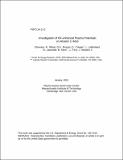Investigation of RF-enhanced plasma potentials on Alcator C-Mod
Author(s)
Cziegler, I.; Myra, J.; Ochoukov, Roman Igorevitch; Whyte, Dennis G.; Brunner, Daniel Frederic; Labombard, Brian; Lipschultz, Bruce; Terry, James L.; Wukitch, Stephen James; ... Show more Show less
DownloadWhyte_Investigation of RF-enhanced.pdf (582.8Kb)
PUBLISHER_CC
Publisher with Creative Commons License
Creative Commons Attribution
Terms of use
Metadata
Show full item recordAbstract
Radio frequency (RF) sheath rectification is a leading mechanism suspected of causing anomalously high erosion of plasma facing materials in RF-heated plasmas on Alcator C-Mod. An extensive experimental survey of the plasma potential (Φ[subscript P]) in RF-heated discharges on C-Mod reveals that significant Φ[subscript P] enhancement (>100 V) is found on outboard limiter surfaces, both mapped and not mapped to active RF antennas. Surfaces that magnetically map to active RF antennas show Φ[subscript P] enhancement that is, in part, consistent with the recently proposed slow wave rectification mechanism. Surfaces that do not map to active RF antennas also experience significant Φ[subscript P] enhancement, which strongly correlates with the local fast wave intensity. In this case, fast wave rectification is a leading candidate mechanism responsible for the observed enhancement.
Date issued
2013-01Department
Massachusetts Institute of Technology. Department of Nuclear Science and Engineering; Massachusetts Institute of Technology. Plasma Science and Fusion CenterJournal
Journal of Nuclear Materials
Publisher
Elsevier
Citation
Ochoukov, R., D.G. Whyte, D. Brunner, I. Cziegler, B. LaBombard, B. Lipschultz, J. Myra, J. Terry, and S. Wukitch. “Investigation of RF-Enhanced Plasma Potentials on Alcator C-Mod.” Journal of Nuclear Materials 438 (July 2013): S875–S878.
Version: Author's final manuscript
ISSN
00223115